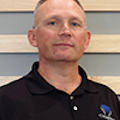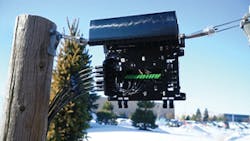Fiber and the Connected Universe —
More than ever, consumer habits are fueling the growth of mobile video, data, IoT, and AI. As a result, there is no stopping the strain on the fixed and mobile networks. And with 5G networks being rolled out by AT&T and Verizon in select cities, the challenges will build exponentially.
Though many think mobile networks are ALL wireless, you know fiber delivers the magic behind the wonders of smartphones and mobile networks. That means more fiber in more places across varied topologies. It means field challenges, cost challenges, and even people challenges.
That’s why ISE magazine is proud to share some real-world insights from Clearfield. As one of the leaders in network transformation, they understand how to solve fiber challenges, so end users can experience all the magic their connected universe delivers.
Aerial and Underground Fiber for the Future
YOURx™-Aerial Terminal for aerial or strand mount applications.
The great debate on how best to build a network includes whether to deploy an aerial or underground network. Of course, each provider needs to look at its geographic territory and determine what would be the best solution. Even though one type of architecture could be dominant, in most cases, a combination of both will exist.
An aerial network is often chosen in order to ease and speed construction. The most notable disadvantage to an aerial network is its visibility. In the early years, customers’ needs for service outweighed the unsightly appearance associated with an aerial network. Today, customers want service, but are concerned with the aesthetics of their neighborhoods — so buried networks are more popular.
Below-grade cabinet.
Considerations when choosing to deploy an aerial network are pole-loading and proper ground clearances. Each time an attachment is made to a pole, it adds more weight. This becomes an issue as the network grows.
When attaching a cable to a pole, calculations must be made to see if it will support all the cables and maintain the proper distance from the ground. A buried deployment has the advantage, in this case, because loading and clearances aren’t issues. However, as the network grows, conduit fill becomes a factor.
Every time a cable is placed in a buried network, the size and fill of the conduit must be considered. Aside from that, timelines can be longer for a buried network because of having to dig or plow conduits or cables into the ground.
Recent Underground and Aerial Updates
Below-grade cabinet in vault.
Fiber cables have a smaller footprint, and weigh less than twisted pair and coax cables. Having a smaller footprint diminishes pole loading and conduit fill issues. Manufacturers continually develop more products that capitalize on fiber being small. Traditionally, providers constructed their buried networks using 4-inch conduits to accommodate twisted pair and coax cables while leaving some room for future growth. Fiber’s inherent small profile doesn’t require a large conduit, but rather can be deployed within microducts that are a fraction of the size of the conduits traditionally used.
Micro trenching, smaller plow machines, and directional bore rigs, are some of the methods used to place microducts. These methods are faster, easier to restore, and less intrusive, than the traditional method of digging a 36-inch deep trench and pouring concrete to encase the large conduits.
Micro trenching is also helpful in a dense urban environment since it can be difficult to tear up streets and get permits from the municipality to block lanes of traffic for extended periods of time. The speed of micro trenching and minimal lane closures address the problems of deploying fiber in a busy community.
Here’s how it works. A small cut is made in the pavement, then 1 or more micro ducts are placed at a depth up to 12 inches. Restoration is made by filling in the cut with an aggregate material. Vehicle and pedestrian traffic can travel over the cut in the pavement during the whole process.
On the aerial front, 2 emerging technologies are being embraced:
Technology #1: All-dielectric self-supporting (ADSS) cable is being deployed, mostly by electric providers. ADSS-style cable speeds up time of deployment because it eliminates the need for a fiber cable to be lashed to a steel strand cable.
Technology #2: Self-support bundled microducts. In the case of bundled aerial microducts, numerous pathways are established on the initial installation. When demand dictates the need to add more fiber, all that’s required is to blow in an additional microfiber.
Providers are constantly pushing to drive the ever-elusive "cost per home passed" number down. An effective way to accomplish this is to minimize the labor needed to construct a network. The means of lashing a fiber cable to a steel strand can take up to 3 visits by a line crew for every pole:
Visit #1: Bore the pole, place a bolt that holds a clamp that will secure the steel strand.
Visit #2: A tech places a rope through cable blocks (pulleys) on the strand. The fiber cable is then pulled with the rope through the blocks.
Visit #3: Use a lasher to wrap a lashing wire around the fiber cable, securing it to the steel strand. Then transfer the lasher at each pole for the entire route.
This method has been used for more than 75 years. However, it can be more efficient. Aerial networks manufacturers need to continuously improve products. As mentioned previously, ADSS in one deployment can help reduce construction time by minimizing the number of visits required at each pole. The drawback to an ADSS solution is that the pole attachment hardware can be costly. The key to improving products and methods for aerial deployments is forging a trusting relationship between open-minded customers and manufacturers that think out of the box.
What’s Trending to Reduce Cost
Keeping an open mind to new products and deployment methods gives providers choices in product suites that will best fit their application.
It’s normal for providers to have multiple networks running parallel to one another. FTTH, business class, and cell backhaul, are just some of the examples of the different fiber networks that exist in the industry. A provider needs a flexible product that will give the technician an easy way to connect a customer in any market segment.
There is also the challenge of overcoming different geographical issues based on where those customers are located. Understandably, products need to incorporate as much flexibility as possible, while providing connectivity in any environment.
In most cases, labor will run 70% of an overall build cost. Consultants and engineers are exploring many different options in an effort to decrease labor costs. A huge industry trend is cascading terminals: a method that aggregates the splicing of fiber cables and utilizes connectorized products in the access portion. A typical design is for a splicer to fuse a 12-fiber cable that will feed a series of terminals. The first terminal would be the only one that requires splicing while the others in the network are plugged in. It would be very similar to cascading power strips. Only the first one would need to be plugged into the outlet; the rest would be plugged in the series.
The 2 types of cascade methods are centralized split, where splitters reside in a cabinet, and distributed split, where the splitters are actually in the distribution terminals. Either method is actively being deployed by providers where they’re seeing labor costs drop and speed of deployment increase.
Demand for Greater Profitability
Deferring capital associated with network builds increases profitability. In an ideal world, a provider should only have to construct a network based upon take rates. Often, however, take rate percentages are a shot in the dark, and can wind up being over or under the forecasted amount. Any time a product can scale to a provider’s demand, it helps add to their bottom line.
Another aspect that impacts profitability is when a technician’s truck becomes a rolling stockroom. The greater the variety of products needed to provide connectivity, the more expensive the deployment becomes. Having the ability to cut down on the amount of supplies a technician needs helps to control cost and increase revenue.
The methods and products used to construct future networks will keep evolving due to the constant demand for increased bandwidth. Proof already exists that a robust fiber network will be needed for 5G backhaul.
For providers to keep up with the exponential increase in bandwidth consumption, an easier-to-deploy network is needed. Translation: the popular term plug-and-play is more relevant for the future than ever.
About the Author





